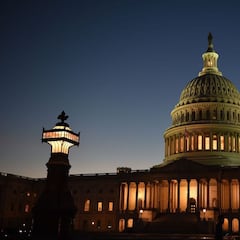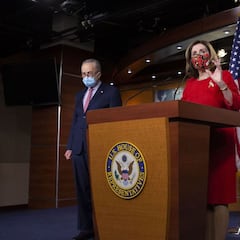$900 billion stimulus relief bill: rundown on checks, loans, school, vaccines...
Sunday 20 December saw the US Congress finally reach agreement on a coronavirus aid package, which is tied to a larger government spending bill.

It's been a long time coming, but finally the US Congress has agreed a stimulus relief package to help American indivudals and businesses to cope with the continuing financial pressures caused by the coronavirus pandemic.
Congress agrees relief package
On Sunday evening, just a few days before many citizens celebrate Christmas an agreement was reached on a $900 billion package. It may be less than some were pushing for, but after the protracted negotiations that have prevented more relief earlier, a confirmation vote on Monday should mean, to use the words of Mitch McConnell, 'more help is on the way'.
BREAKING: As the American people continue battling the coronavirus this holiday season, they will not be on their own.
— Leader McConnell (@LeaderMcConnell) December 20, 2020
Congress has just reached an agreement. We will pass another rescue package ASAP. More help is on the way.
As Senate Democratic Leader Chuck Schumer has said, this is another step, but should not be the end of govermental support:
"After weeks of intense negotiation, we've reached an agreement on an emergency #COVIDrelief package. It will deliver emergency relief to a nation in the throes of a genuine emergency. We must make law as soon as possible.
After weeks of intense negotiation, we've reached an agreement on an emergency #COVIDrelief package.
— Chuck Schumer (@SenSchumer) December 20, 2020
It will deliver emergency relief to a nation in the throes of a genuine emergency. We must make law as soon as possible.
And then we need to do even more under President Biden.
And then we need to do even more under President Biden."
This latter part is especially important given the growing impact of the virus across the country, which you can follow on our daily live blog.
What does the $900 billion package look like?
The bill is a wide ranging one that includes individual payments to needy Americans, unemployment benefits, school initiatives and funding for covid-19 vaccine development among other aspects. Based on a summary released by Nancy Pelosi, Speaker of the House of Representatives, and Chuck Schumer, as well as other reports, this is what is included:
Stimulus checks
The bill includes $166 billion in new direct payments of up to $600 per adult and child, for individuals making up to $75,000 a year and $1,200 for couples making up to $150,000 a year.
This bill expands direct payments to mixed-status households.
Unemployment benefits
An additional $300 per week for some unemployment recipients.
US Postal Service grant
Congress agrees to convert a $10 billion loan approved in March into direct funding for USPS without requiring repayment.
Payroll loans
$284 billion for government payroll loans, including expanded eligibility for nonprofits and newspaper and TV and radio broadcasters, $15 billion for live venues, independent movie theaters, and cultural institutions and $20 billion for targeted disaster grants
Statement from President-elect Biden on bipartisan agreement on COVID-19 relief:https://t.co/sIC4FmXdDe pic.twitter.com/83B8LeWiHZ
— The White House (@WhiteHouse) December 21, 2020
Funding for 'back-to-school'
$82 billion for colleges and schools, including for heating-and-cooling system upgrades to mitigate virus transmission and reopen classrooms, and $10 billion for childcare assistance. Includes $54.3 billion for K-12 schools and $22.7 billion for higher education.
Business meal write-offs
A new tax break for business meal expenses, nicknamed the "three martini" deduction.
An end to surprise medical billing
Insured patients only need to pay in-network costs when an emergency or other issue forces them to use a medical provider who isn't covered by their network.
- How much will adults and children receive in the new stimulus package?
- New stimulus checks will not cover a month's rent for many Americans
- How long until the second stimulus check arrives?
- State-by-state guide to Christmas travel restrictions
Transport industry help
$45 billion for transportation aid, including $15 billion to US passenger airlines for payroll assistance, $14 billion for transit systems, $10 billion for state highway funding, $2 billion for airports, $1 billion for airline contractors and $1 billion for passenger railroad Amtrak.
Rent and eviction aid
$25 billion for rent and utility payment assistance for people struggling to stay in their homes, and an extension of the eviction moratorium until Jan. 31. States will receive a minimum of $200 million in assistance.
🚨🚨WE HAVE A DEAL! 🚨🚨
— Diane Yentel (@dianeyentel) December 20, 2020
It includes:
✅ CDC eviction moratorium extended through Jan 31!
✅ $25 BILLION in emergency rental assistance!
✅ Extended deadline for spending CRF rental assistance $!
❗️THANK U FOR YOUR ADVOCACY❗️
Let’s get it enacted ASAP!
Vaccine distribution aid
$30 billion to support procurement and distribution of the vaccine, "ensuring it's free and rapidly distributed to everyone," as Schumer said.
More to fight hunger
$13 billion for food assistance, including additional funding for food banks and senior nutrition programs, college student access to the federal government's Supplemental Nutrition Assistance Program.
Farm aid
Another $13 billion for direct payments, purchases and loans to farmers and ranchers.
Expanded Pell Grants
New grants for college tuition, which would reach 500,000 new recipients.
Internet access
$7 billion to give more Americans broadband internet access, including $1.9 billion to replace telecom network equipment that poses national security risks and $3.2 billion for a new temporary benefit program to help low-income Americans get access to broadband service
Thank you to Congress for including #SaveOurStages in the relief plan!
— Keith Powers (@KeithPowersNYC) December 21, 2020
It’s long overdue to help our performing arts and independent music venues survive the pandemic.
Big thanks to @SenAmyKlobuchar and @SenSchumer for their hard work. https://t.co/Jdag6ZUUy1 pic.twitter.com/RihaMR3tHF
Global virus alliances
$4 billion for an international vaccine alliance.
Tax credits
Enhanced tax credits to encourage low-income housing construction, businesses to keep employees on payroll, employers to provide paid sick leave, and for low income workers.
Minority-owned businesses
$12 billion for minority owned and very small businesses that struggled to access earlier Payroll Protection Program financing.
What’s not included in the relief bill?
Clearly the above list is fairly comprehensive but there were a couple of key elements not included in the bill.
Related stories
Liability protection for companies whose employees get coronavirus, which Republicans have backed for months, was not including in the final negotiations or bill; Democrats laid aside sizable funds for state and local governments in return.
A last-minute attempt by the Republican Party to limit the Federal Reserve’s emergency lending power to small businesses and local governments was also left out.

